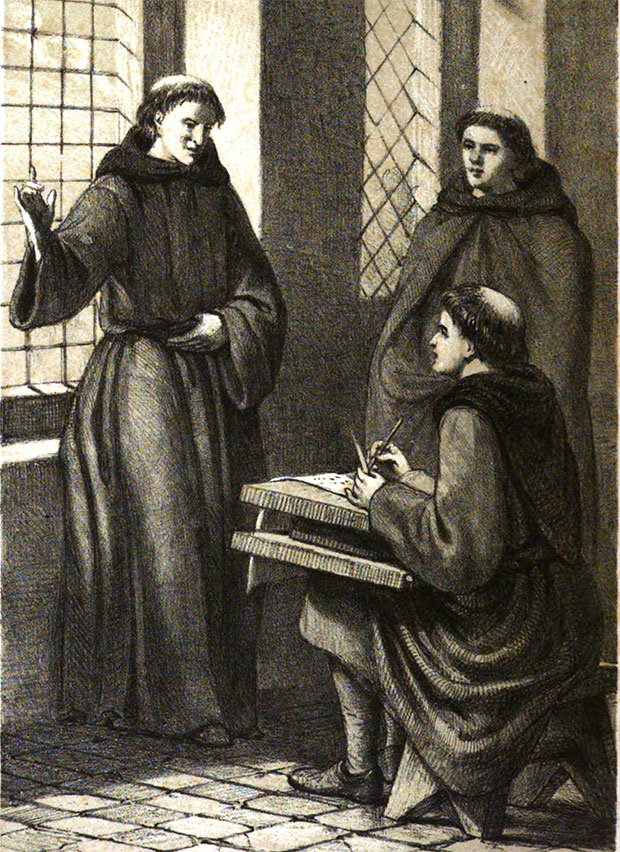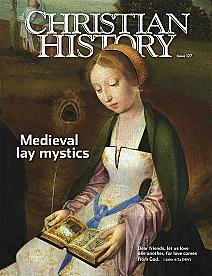FAITHFUL GROOTE SOUGHT SOULS IN SPITE OF JEALOUS CLERGY

[Above: Brothers of the Common Lot, from De Klooser-orden in Nederland (The Monastic Orders in the Netherlands), 1874 public domain]
EUROPE at the start of the fourteenth century was prosperous but morals were low. The schools taught a subtle but dry scholasticism. The papacy had reached its height of power but was soon to split along political lines creating two and eventually three rival popes. Ordinary people hungered for authentic Christianity, and several associations had arisen to meet that need, including the persecuted Waldensian movement and the Franciscan and Dominican orders.
In the Netherlands the desire for authentic Christianity found expression in mysticism, the attempt to form a direct relationship with God through the spirit. Among its most articulate and exemplary advocates was Jan van Ruysbroeck. However, its most practical expression came through the Brethren of the Common Life (or Common Lot).
The Brethren came into being through the combined efforts of Geert de Groote and Florentius Radewyns. Fascinated with science and gifted with the desire to teach, Groote had studied at Paris and Cologne. He emerged foppish and worldly, frittering time on amusements. However, Christian acquaintances appealed to his nobler nature. Groote promised, by God’s aid, to reform. After three years of ascetical contemplation, he obtained a license to preach across the diocese of Utrecht. His earnest appeals, made in Low German, brought conviction to the hearts of many listeners. However, the clergy were infuriated by his exposure of their corruption and got his license revoked.
Groote then visited Jan van Ruysbroek and was deeply impressed by his spirituality and by the simplicity of life at his Grunthal monastery. He determined to establish a similar institution. He returned to his native Deventer, where he shared his knowledge and his books with young scholars and provided them an income copying books. A society grew up, devoted to Holy Scripture and to godly writings.
This Deventer fraterhuis became the model for several daughter houses. These had no hierarchy and did not require the irrevocable vows monks took. Desirous of living in the manner of early Christians, they shared their goods in common, worked for the general good, and devoted their leisure hours to prayer and works of charity. The Brethren houses were primarily devoted to free education, so that reading and writing were accessible to both rich and poor; and their instruction was without either the superstition of the monasteries or the sophistries of the schools. They emphasized the Gospels, church fathers, and practical skills.
Groote had intended to found a convent of regular canons, but died before he could, on this day, 20 August 1384, having contracted plague while tending its victims. To those weeping at his death bed he said, “Lo, I am now summoned by the Lord. The hour of my departure is come. Augustine and Bernhard are knocking at the door. The limit appointed me by God I cannot pass.”
Among the famous pupils to emerge from the Brethren schools were Nicholas of Cusa, who became a cardinal known Europe-wide for his originality and learning, and Thomas à Kempis, author of The Imitation of Christ. À Kempis labored all his life at the most famous of the Brethren daughter houses, Mount St. Agnes. Another famous pupil was Erasmus, who fired some of the opening shots of the Reformation.
Many monks and friars resented the influence of the Brethren, whom they hated as rivals. About twenty-five years after Groote’s death, they appealed to the Council of Constance to shut down the movement, claiming an exalted status for monks and friars. Jean de Gerson responded that there is but one religion, the religion of Christ, which can be practiced without vows and needs nothing to add to its perfection. The council adopted his answer and Pope Martin V agreed, and the Brethren of the Common Life were subsequently left in peace.
—Dan Graves
----- ----- -----
Groote was one of the figures who inspired medieval lay mystics, a story told in Christian History #127






